The Fundamentals of Making Hummus
I am a huge fan of hummus. It's easy to make from scratch and infinitely more delicious than store bought varieties. It's difficult to make a hummus recipe, though, without contemplating: chickpeas or garbanzo beans? These are, in fact, different words for the exact same thing. "Chickpea" is the Latin word and "Garbanzo Bean" is the Spanish derivative. But that doesn't settle the debate. Do you use chickpea or garbanzo bean? And are they even beans or peas at all??
I tend to not mince words with my recipe titles. I'm not one to use flowery language like, "traditional" or "grandma's favorite" or "the best ever." Nothing about most of what we make is remotely traditional. I have no firsthand experience that any of my grandparents knew what a chickpea or garbanzo bean was. And, unless you've both created and also won a global hummus-making contest, then you're taking an entirely subjective classification and merely claiming that you're the best at it.
Most of my recipe titles merely describe what they are. But this doesn't work as well if we can't figure out what to describe hummus as! Is it "Chickpea Hummus?" Or "Garbanzo Bean Hummus?" Do we try to mitigate all potential confusion and call it "Chickpea/Garbanzo Bean Hummus?" Perhaps simpler is better and just "Hummus" is the answer?
Chickpeas and garbanzo beans are two names for the same thing, though. And while we might get out of this conundrum by calling it "Quick and Easy Hummus" or "Traditional Hummus," we've already poked holes in that line of reasoning as well. I would rather call something for what it is than come up with gimmicky titles. Maybe not the best business plan, but you'll have to forgive me for not wanting to fuel the clickbait traps!
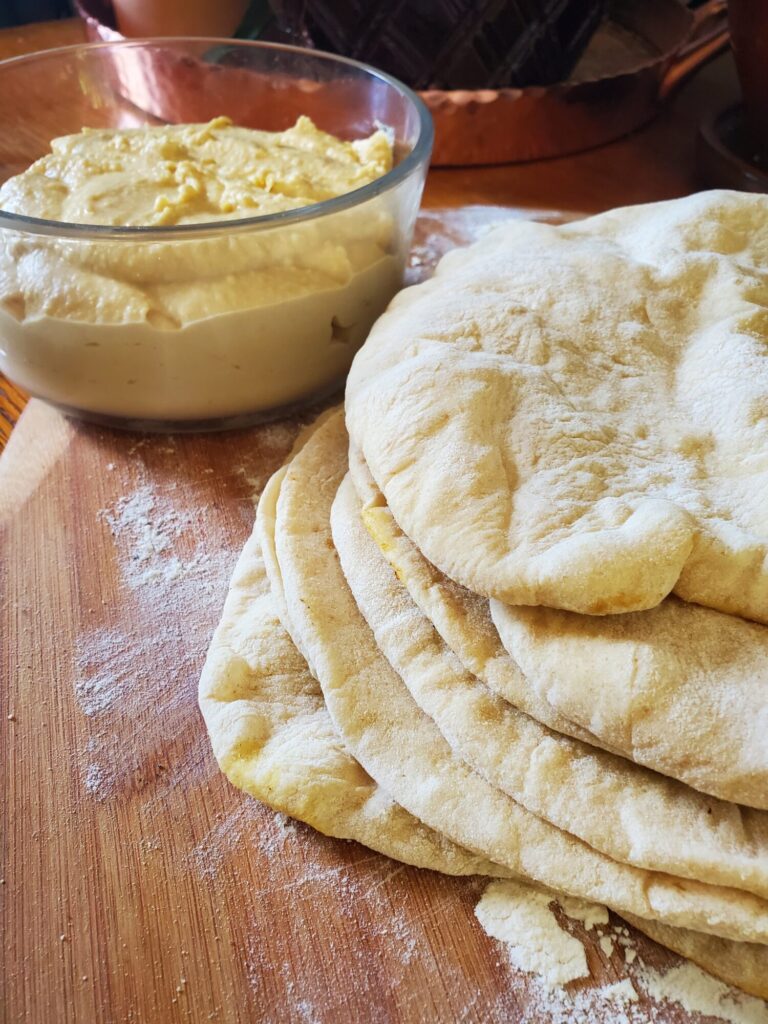
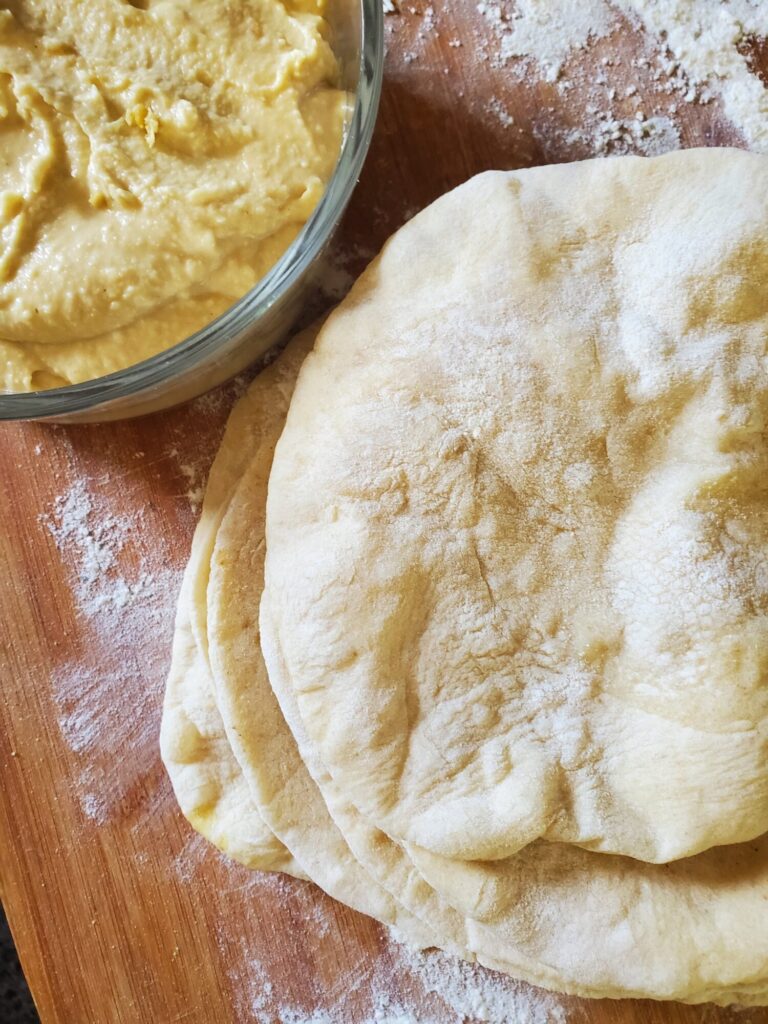
Origin of Hummus and the Terminology Debate
The first time that I wrote down this recipe, almost a decade ago, I used the term "garbanzo beans." Probably because I think that most of the time in the United States they're called chickpeas and I like to zig when others zag. But why is that?
Everything that we make is filtered through the lens of geographic location, moment in time, particular ingredients, and personal history. And chickpeas/garbanzo beans are no exception.
Hummus is thought to have originated in Egypt in the 13th century and has been a staple of Greek and Middle Eastern cuisine for centuries. The word "hummus" means "chickpea" in Arabic (The Spruce Eats' "Is Hummus Greek or Middle Eastern?").
"Chickpea" is also the Latin word for "cicer," the plant genus that chickpeas/garbanzo beans are a part of, and "garbanzo bean" is the Spanish word for the legume (Bon Appétit's "The History of the Word Chickpea").
I am merely speculating here, but I would wager to say that the United States tends to have more of a Latin than Spanish influence. Latin is intrinsically tied to Rome and the landscape of the British and Spanish Empires. However, as longstanding rivals, Britain likely wouldn't have adopted too many Spanish customs and would have held onto the Latin term for the legume. The United States, being a former British colony, I would assume also took on the Latin "chickpea" more than the Spanish "garbanzo bean." And I would suspect that in Spain and in places with a more Spanish influence, "garbanzo bean" would be the more common term. Although again, I'm just speculating here.
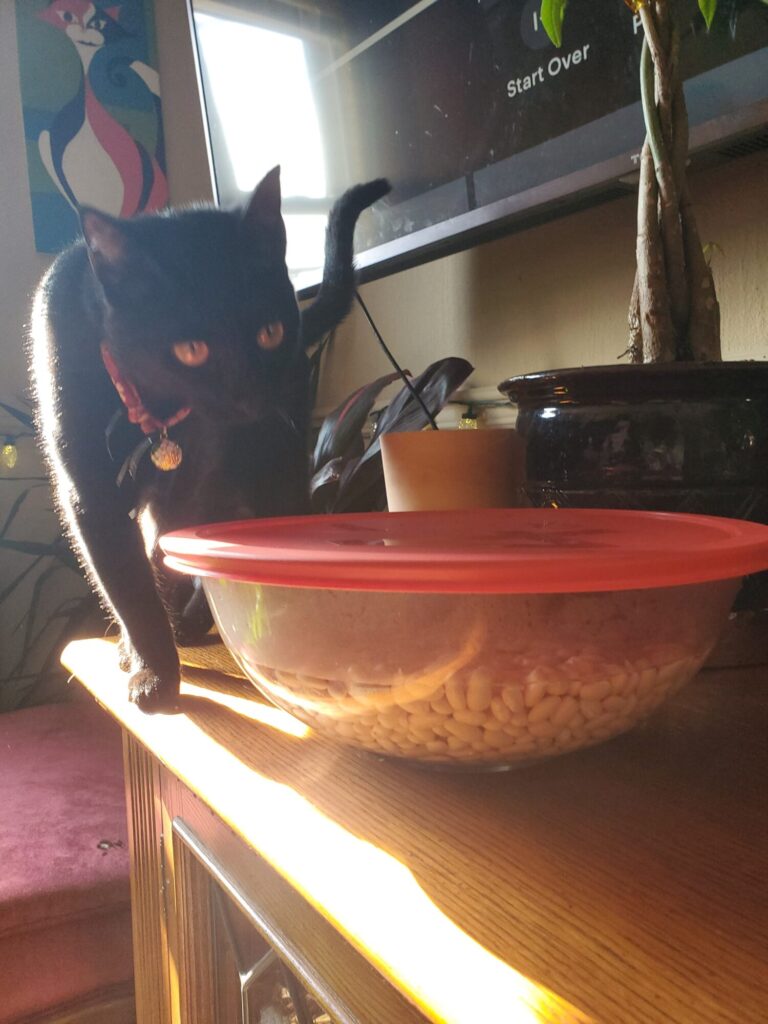
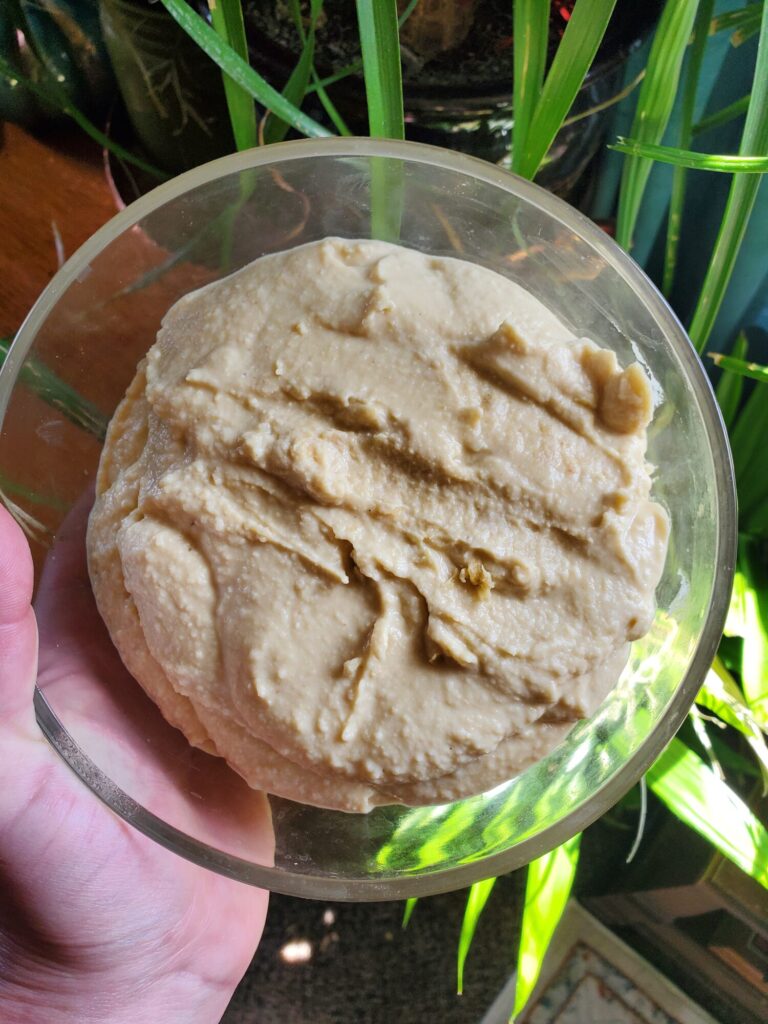
What ARE Chickpeas/Garbanzo Beans?
Chickpeas/garbanzo beans are a legume and cousins of beans and peas. What we tend to think of as beans, kidney beans, black beans, pinto beans, navy beans, white beans, etc. are all a part of the Phaseolus L. (Bean) genus. Likewise, sugar peas, garden peas, and field peas are all a part of the Pisum L. (Pea) genus. Less common in the colloquial nomenclature, chickpeas/garbanzo beans are part of the Cicer L. (Cicer) genus. This makes all of them a part of the Fabaceae (Pea Family).
What all of this means, is that chickpeas/garbanzo beans are more like cousins than siblings. Beans, peas, and cicers are all a part of the greater Fabaceae (Pea Family). So, while beans, peas, and chickpeas/garbanzo beans could all be described as "peas," not all peas are beans and we're using the word "pea" as both a greater taxonomic term and specific reference to actual peas.
graph TD A["Kingdom (6)"]-->B["Subkingdom (1)"] B-->C["Superdivision (1)"] C-->D["Division (5)"] D-->E["Class (2)"] E-->F["Subclass (6)"] F-->G["Order (13)"] G-->H["Family (13)"] H-->I["Genus (34)"] I-->J["Species (9)"] J-->K["Colloquial Variety"] P["Plantae (Plants)"] P-->R["Tracheobionta (Vascular Plants)"] R-->X["Spermatophyta (Seed Plants)"] X-->AG["Magnoliophyta (Flowering Plants)"] AG-->AI["Magnoliopsida (Dicotyledons)"] AI-->AL["Rosidae"] AL-->BB["Fabales"] BB-->BG["Fabaceae (Pea Family)"] BG-->BV["Cicer L. (Cicer)"] BV-->CK["Cicer arietinum L. (Chick Pea)"] CK-->CM["Chickpea/Garbanzo Bean"] BG-->DA["Phaseolus L. (Bean)"] DA-->DB["Phaseolus vulgaris L. (Kidney Bean)"] DB-->DC["Pinto Bean"] DB-->DD["Black Bean"] BG-->DE["Pisum L. (Pea)"] DE-->DF["Pisum sativum L. (Garden Pea)"] DF-->DG["Snap Pea"] DF-->DH["Snow Pea"] style A fill:#7dac2f style B fill:#7dac2f style C fill:#7dac2f style D fill:#7dac2f style E fill:#7dac2f style F fill:#7dac2f style G fill:#7dac2f style H fill:#7dac2f style I fill:#7dac2f style J fill:#7dac2f style K fill:#7dac2f style P fill:#cdcd10 style R fill:#cdcd10 style P fill:#cdcd10 style R fill:#cdcd10 style X fill:#cdcd10 style AG fill:#cdcd10 style AI fill:#cdcd10 style AL fill:#cdcd10 style BB fill:#cdcd10 style BG fill:#cdcd10 style BV fill:#cdcd10 style CK fill:#cdcd10 style CM fill:#cdcd10
Final Answer: Chickpeas or Garbanzo Beans?
My final answer on the matter is that chickpeas/garbanzo beans aren't actually beans. I have three more or less valid reasons for this:
1. Taxonomically speaking, they're a pea. And, while all beans are peas, not all peas are beans. This means that calling them a "pea" is more accurate than a "bean," because they are not amongst the bean genus. They're not amongst the smaller pea genus, either, but they are of the higher pea family of classification.
2. "Chickpea" is the Latin word for "cicer" and "garbanzo bean" is the Spanish derivative for the same thing. This seems to mean that the term "chickpea" presupposed "garbanzo beans."
3. I had also already labeled my last container of the legume "chickpeas." Likely because that is the name that the bulk bin in the grocery store named them. However, changing my mind at this point would mean having to scrub the ink off of my chickpea jar and relabel it! Which, quite frankly, I'm just less inclined to do because keeping it as is is easier.
So, unless anyone can give me a more justifiable reason to call them anything else, I'm going to go with "chickpeas."
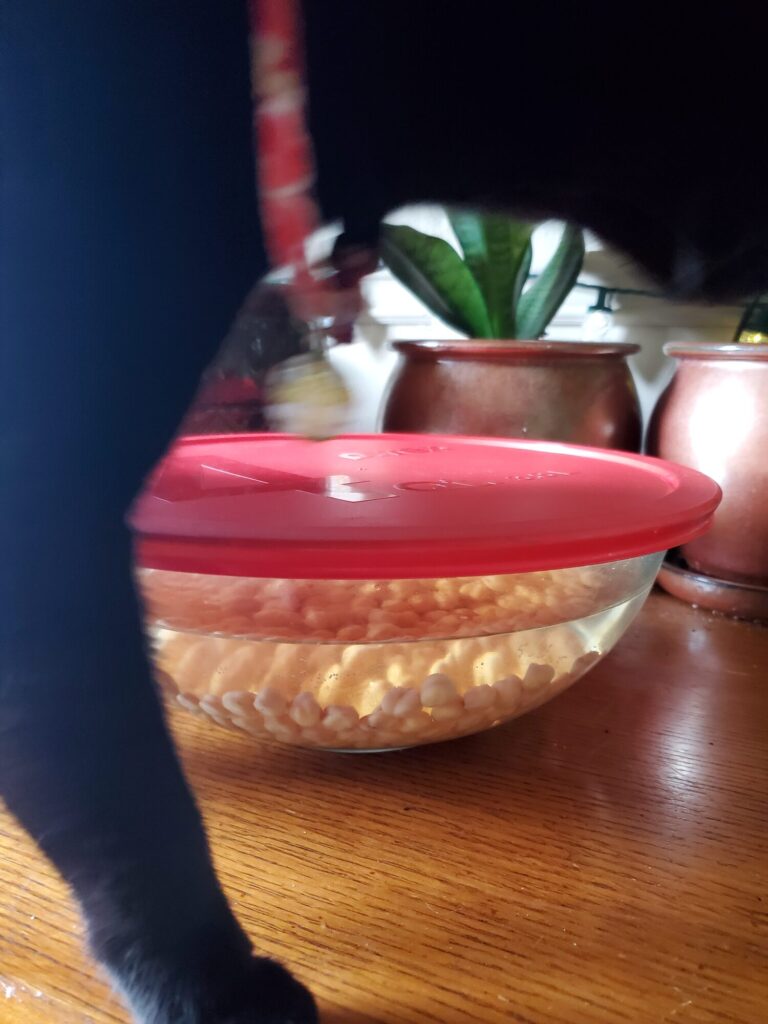
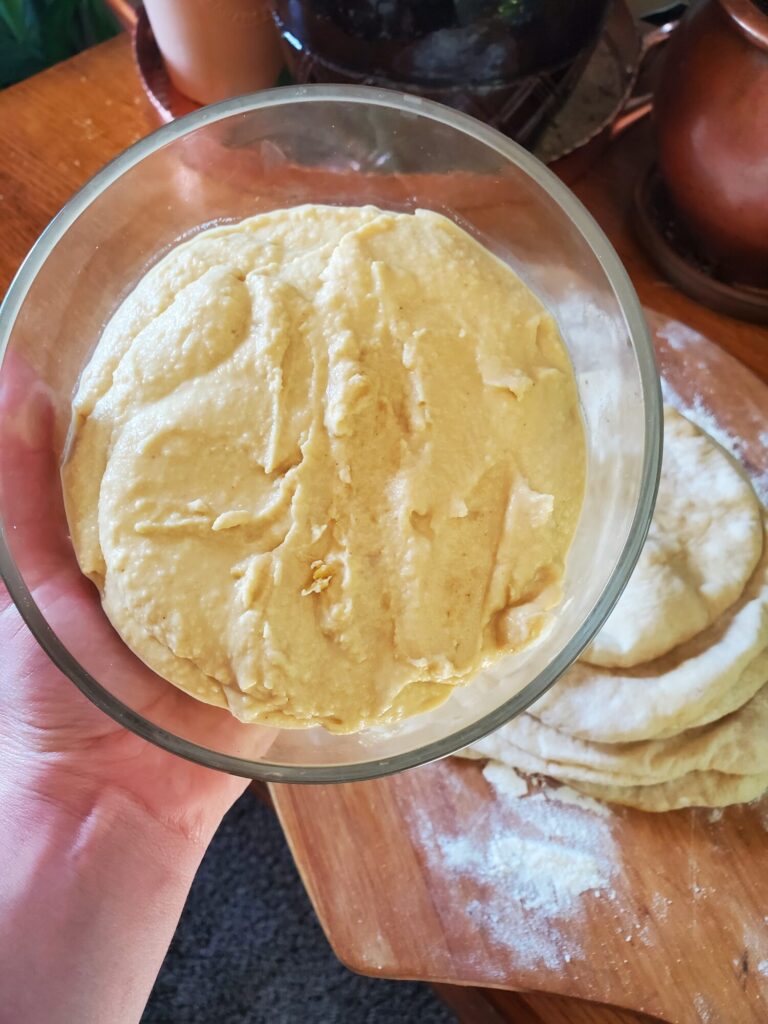
Tips and Tricks to Making Hummus
Now that we have the terminology out of the way, how exactly do you make hummus? There are a few things that are absolutely key.
Dried Chickpeas
For starters, dried chickpeas are essential. There are plenty of recipes out there that call for canned chickpeas. But this really is the quintessential mistake most people make when starting out on the hummus journey. And, if you start to go through the comments on these recipes, you're bound to come across complaints about the texture.
This is because canned garbanzo beans are grainy. They're pre-cooked and brined, almost always with additional salt, and create a viscous film that is texturally unpleasant and needs to be washed off. This film is called aquafaba and my favorite description for it is, "translucent viscous goop you probably rinse down the drain when you open a can of chickpeas" (Bon Appétit's "Everything You Need to Know About Aquafaba").
When you cook and soak legumes, the starches and protein are released and create a gelatinous goo. Something similar occurs when you cook down bones to make gelatin. The problem with this is that, you don't want your hummus to be gelatinous! It also creates a texturally unpleasant film that is less flavorful and often slightly discolored when compared to freshly cooked lentils.
I'm all for quick and easy cooking methods and would love to not have to plan ahead and soak garbanzo beans overnight. But, you really can't skip this step! As much as some of these recipes might show fanciful pictures of carefully styled and exquisitely lit hummus that looks delectable. It's the taste taste that matters and canned chickpea hummus will never live up!
So, as much as it might be tempting to skip the cooking step, you have been warned! It is essential.
Remove the Skins
Do you have to remove the skins? No. Do I debate over this every single time that I make chickpeas because it absolutely would be easier to forgo it? Absolutely! Do I do it anyway? Unfortunately, yes.
Making hummus is an endeavor. It takes planning the day before to soak the chickpeas. Several hours to cook them. And then the tedious labor of removing all of the skins before puréeing. When I'm that close and it's taken so long to get there, all I want to do is skip this step and have hummus, already!
But graininess is the bane of hummus existence and it would be such a shame to ruin it at the last minute. Unfortunately, the people who tell you that you don't have to remove the skins are usually the same people who tell you that you can also use canned chickpeas. While you can make hummus using canned chickpeas and you can make hummus without removing the skins when you do cook your own, this will never produce the same texture as we're accustomed to! The key to perfect hummus is the smoothness of the consistency. Leaving in anything that might disrupt this is tantamount to blasphemy in the hummus world.
Now, luckily you don't have to get rid of ALL of the skins. But any amount of effort will pay off. It's similar to blanching tomatoes. When it's just for me, I don't mind a couple of tomato skins in my sauce. When it comes to making it for other people, though? Just get it over with as quickly and painlessly as possible! Because it does make a difference.
Types of Food Processors
This is one of those recipes where a high-powered blender or food processor is necessary. I may make cookies by fork and mashed potatoes by masher, but this is not one of those scenarios where doing it by hand will cut it!
In a recipe on Hummus w/ Roasted Pumpkin, I tested out the difference between using a Cuisinart food processor and Vitamix blender. Oftentimes the Cuisinart does perfectly well and I'm debating over whether or not the Vitamix is worth it. To which, I'm perpetually of the conclusion it is. But is it better for making hummus?
The Vitamix created a smoother consistency than the Cuisinart and did so without the use of ice. A lot of the time I'll add ice to the hummus. The rapid cooling helps to purée more smoothly. I'm not always great at keeping ice on hand, though, and using the Vitamix allowed me to bypass this step without having the residual graininess that's endemic in bad hummus!
Enough to send all of you scrambling out to purchase another kitchen appliance?
While the Vitamix did do a better job at creating a smoother consistency, it didn't perform so much above and beyond the Cuisinart that I would recommend it if you didn't already have one! Although I would wager that either would be preferable to less powerful methods, like an immersion or bullet blender. Although I've never attempted to use these to make hummus, I've watched other people attempt the endeavor and it always makes me cringe!
Gallery
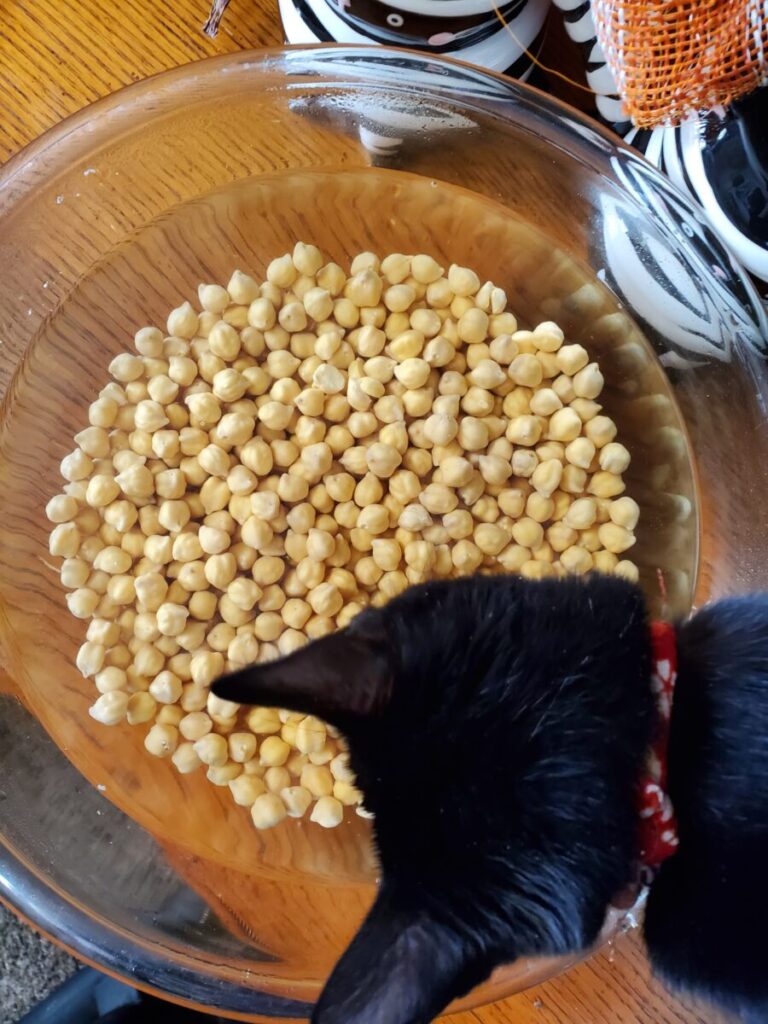
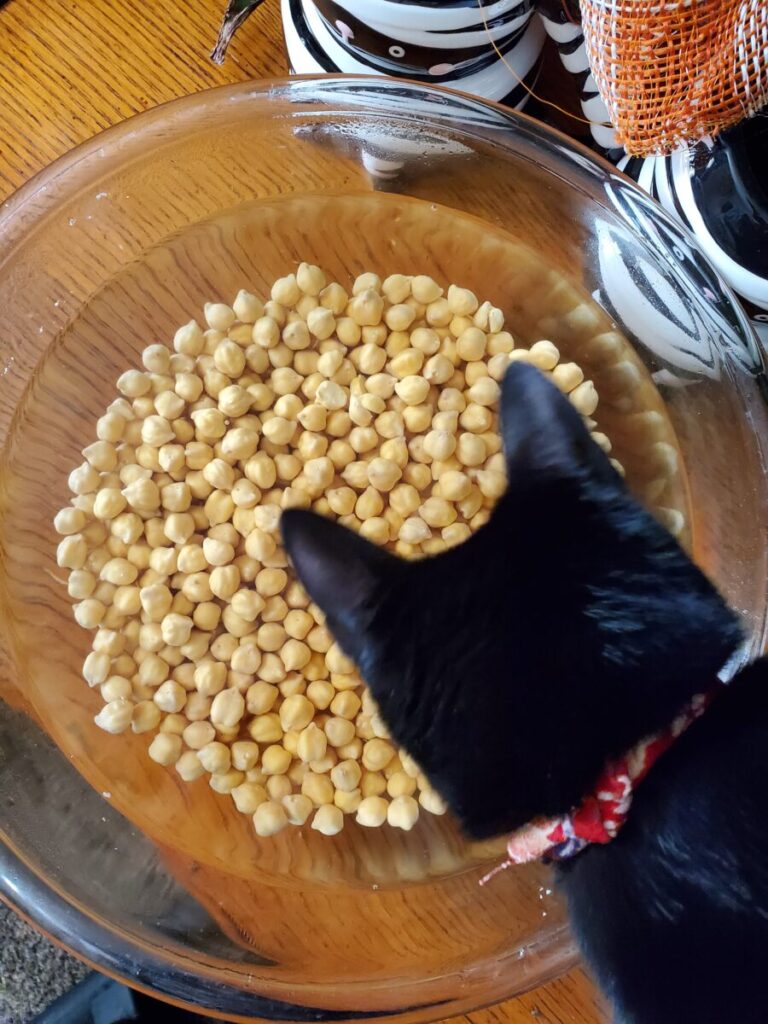
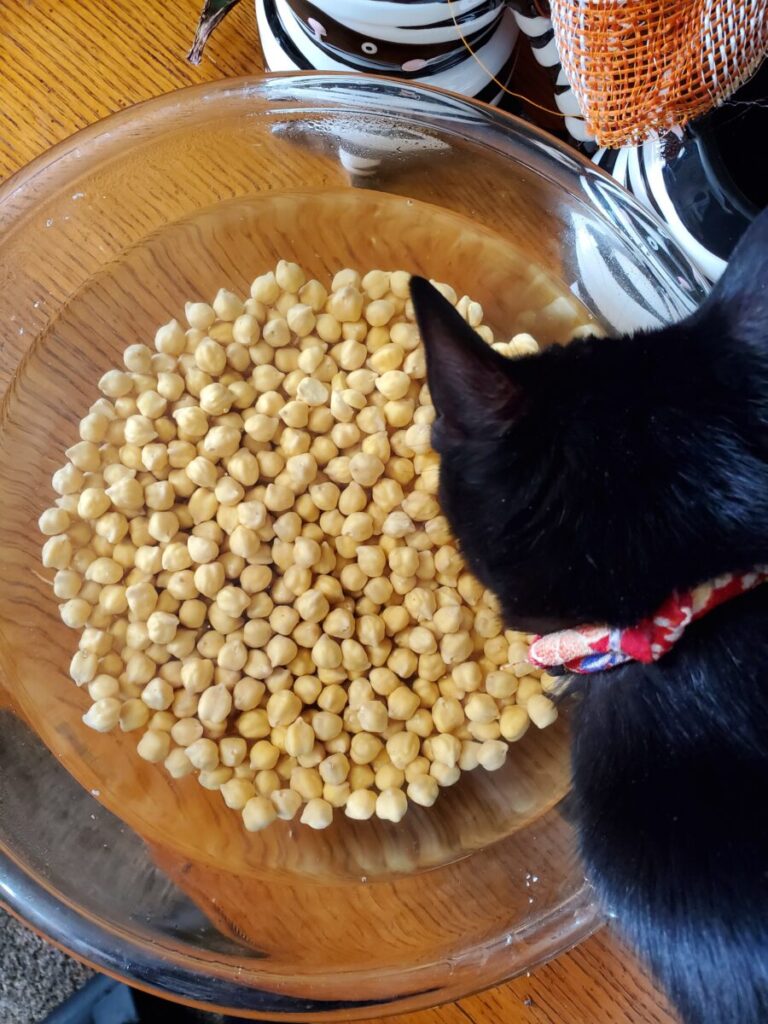
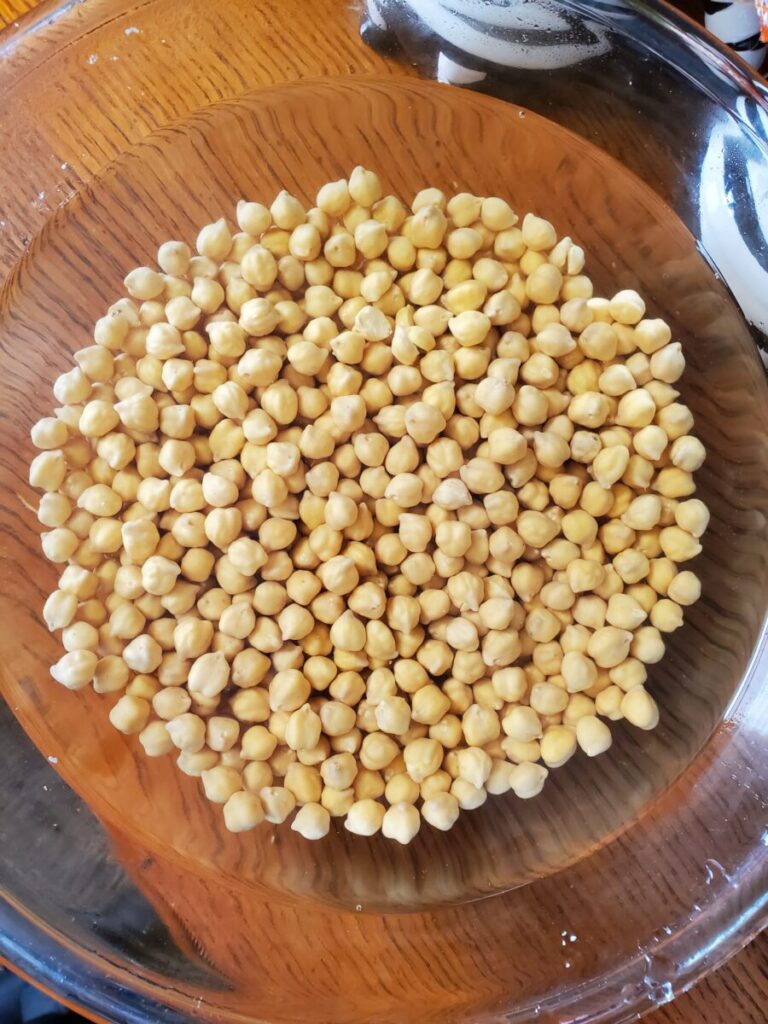
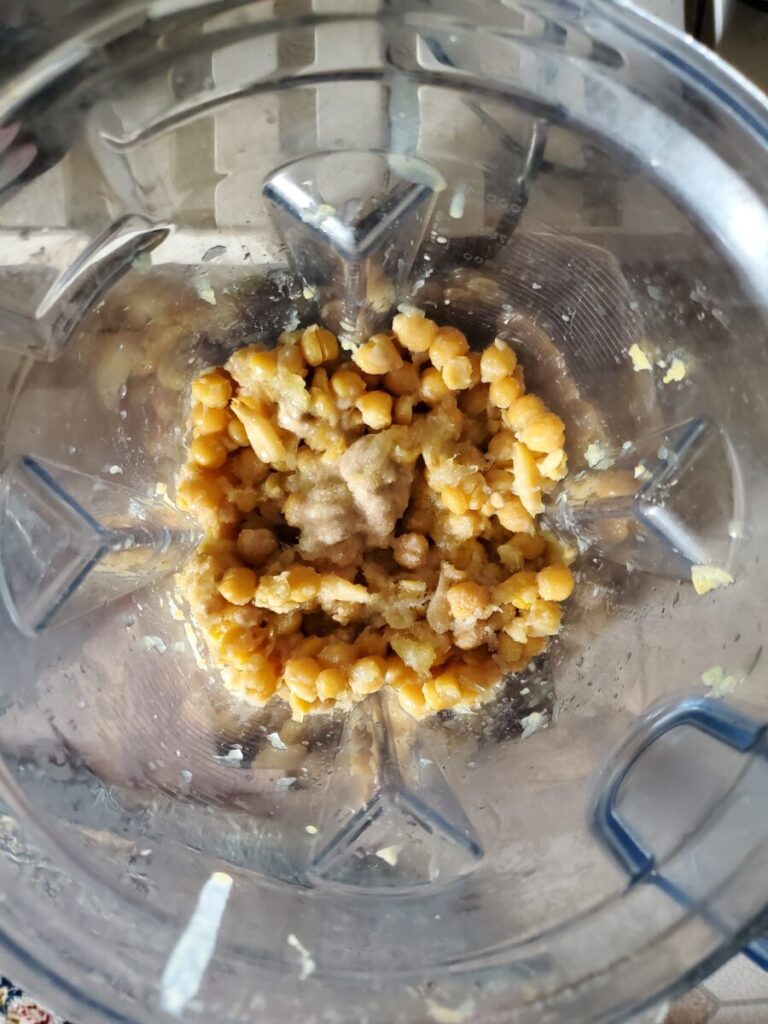
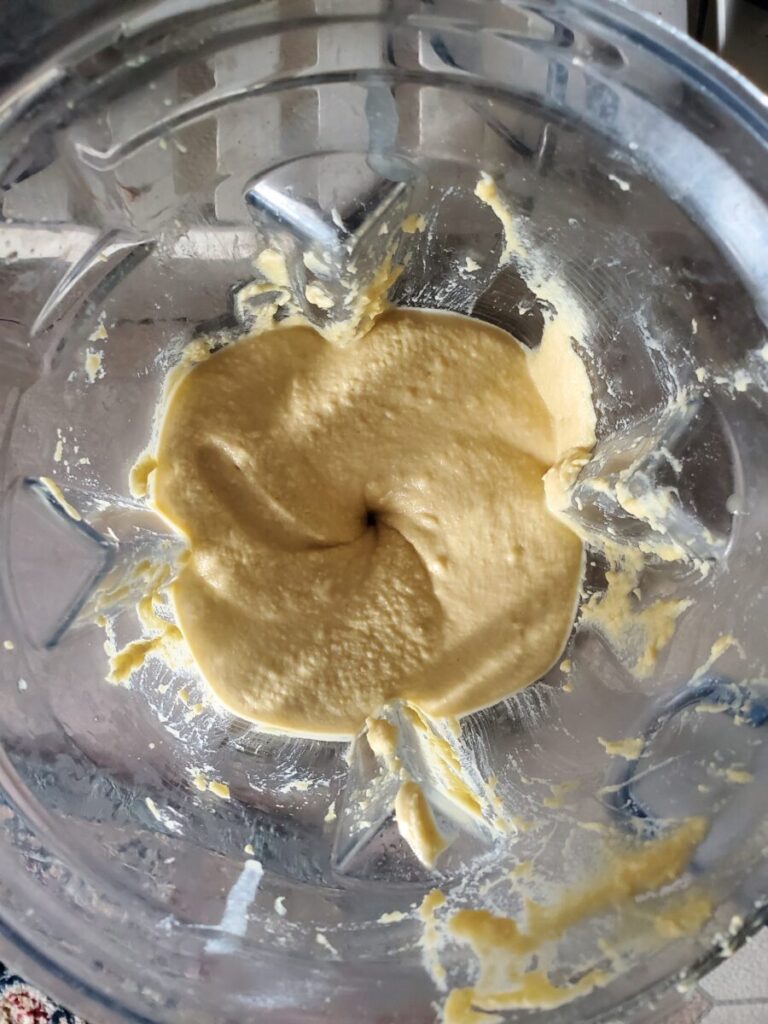
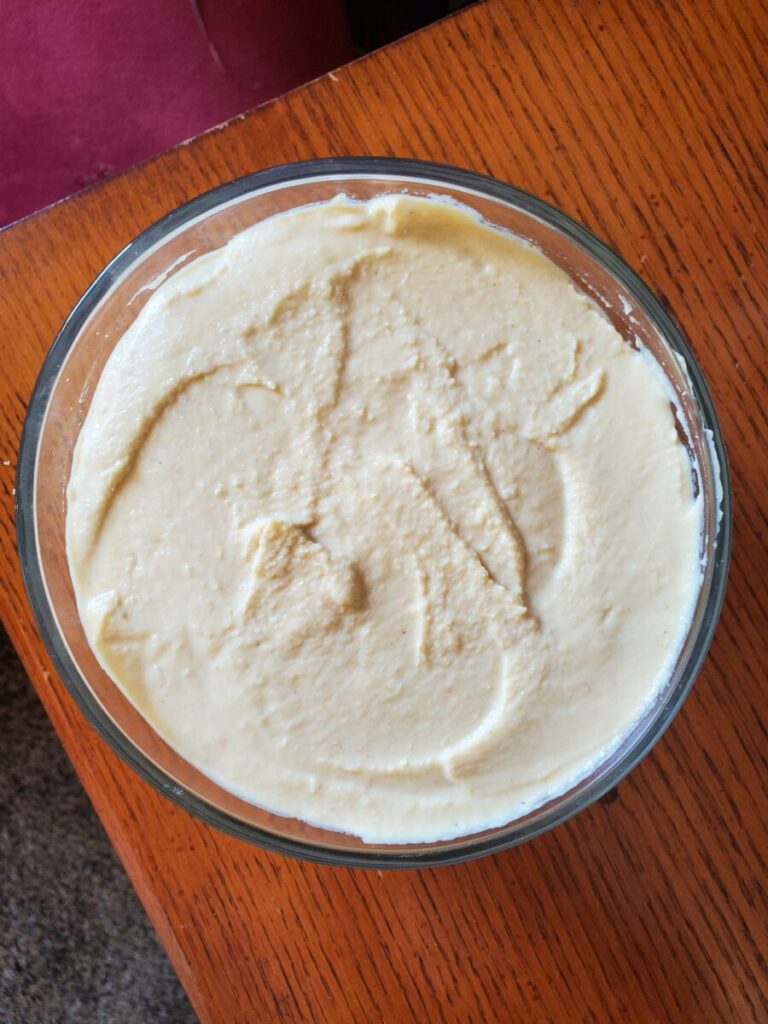
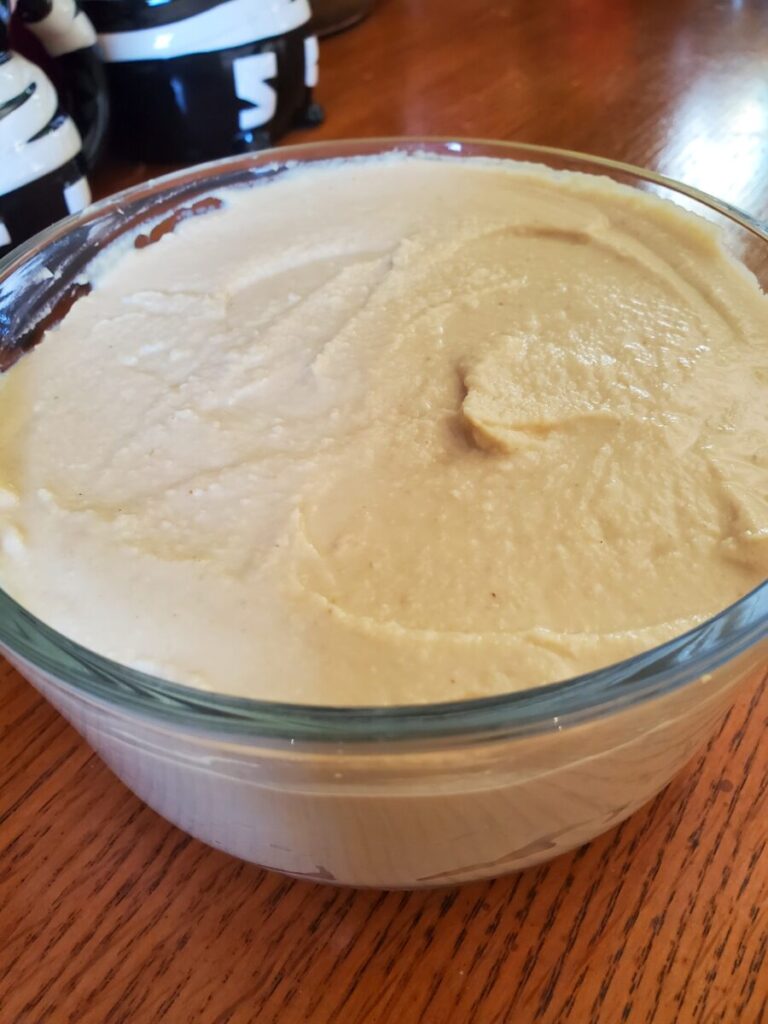
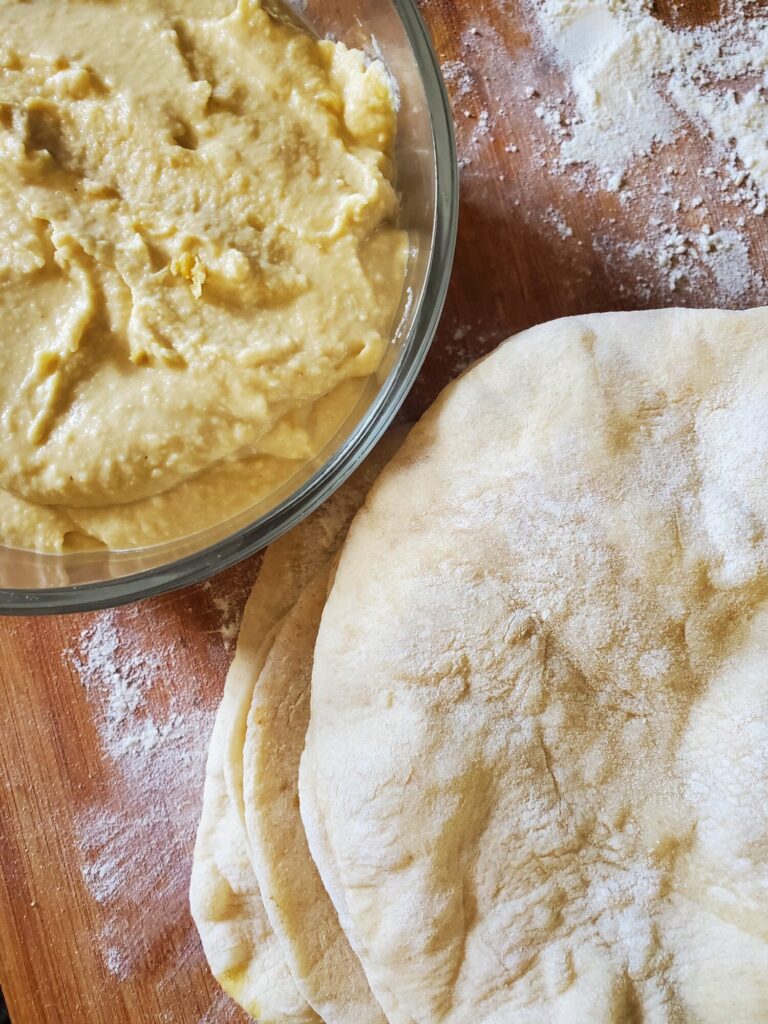
What to Make w/ Hummus?
Whatever you call it, hummus is also incredibly versatile. It's often thought of in Greek or Middle Eastern food alongside pita bread and in the same realm as baba ghanoush. And I absolutely do this all of the time!
But I'll also add it in a lot of foods. Hummus adds creaminess and thickens a dish without having to add dairy. This is great for in soups or curries.
A lot of the time I'll put it on top of burritos in place of sour cream as well.
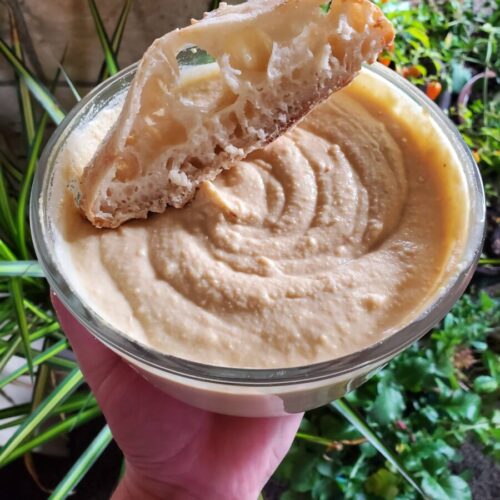
The Fundamentals of Making Hummus
Equipment
- Food Processor
Ingredients
- 2 c. chickpeas soaked overnight
- 2 lemons juiced
- 5 cloves roasted garlic (or 2-3 cloves unroasted garlic)
- 1 tbsp. tahini
- 2 tbsp. olive oil
- 1/2 tsp. cumin
- 1 tsp. salt
- 1/2 c. crushed ice (optional)
Instructions
Soak Chickpeas Overnight
- Soak chickpeas/garbanzo beans in cold water for at least 12 hours.I like to do this overnight because then you're asleep during the down time. Although you can soak them in the morning and still be able to cook them in the evening.Just don't skip this step! Soaking is important to the hummus-making process. It is also vitally important NOT TO USE CANNED CHICKPEAS. The texture won't be the same. And, since hummus is defined in large part by its texture, no matter how closely you get the flavor to match, the graininess of canned chickpeas is noticeable.
- I also tend to use Roasted Garlic to make hummus. This is entirely optional, though. You can easily use half the amount of unroasted garlic.If you do want to roast garlic, though, you'll need a head of garlic (or several if you want extra), a drizzle of olive oil, and a garlic roaster or aluminum foil. It takes 5 minutes of prep time and about an hour to cook. They're easy to toss in the oven while you're simmering the chickpeas.
Cook Chickpeas
- Drain the chickpeas. Add to a large pot and cover with a couple inches of water.
- Bring to a boil and then reduce heat to a simmer.
- Simmer for 1 1/2 - 2 hours, or until tender. You may need to adjust the temperature to keep them from boiling as they cook down.The chickpeas are done when they're soft and begin to shed their skin. This is much like the consistency of a barely boiled potato. They should still keep their shape and not turn to mush, but would theoretically split in half if you pierced them with a fork.If, when you go to remove the skins, you're peeling them off each individual chickpea, they're not cooked enough. If they chickpeas are just crumbling and everything is turning to moosh, they are overcooked! Undercooked chickpeas will likely need to be put back on the stove. Overcooked chickpeas aren't necessarily ideal, but are still usable. Just something to note for next time.
- Drain the chickpeas immediately after cooking.
Remove Skins
- This is arguably the worst step to making chickpeas! You don't have to remove every single skin, but the more that you do remove, the better the texture of the hummus will be. And we don't want to go through all of the effort to make hummus from scratch and then get lazy about it in the end. The skins are tough and give it a grainy texture. Which is not what you're looking for in something that should be soft and smooth! So, get as many of them off as you can muster.
- The simplest way that I've found to remove the skins as quickly and easily as possible is to run them under cold water until cool. Then, place them in a large bowl, fill with enough water so that the chickpeas are covered by at least 1/2 an inch, and rub a handful of chickpeas between your palms at a time. Much like you're doing the "Buuuuuuuuur, I'm cold!" motion. The skins should separate and float.If you've cooked the chickpeas long enough, the skins should easily slide off of the chickpeas. If you've cooked them too much, this will cause the chickpeas to break apart and disintegrate. If you're close to the right cooking time, you should be fine. It can be difficult to remove as many skins as you would have otherwise and you may get some graininess in the end result, but you should still get delicious hummus out of it!
- Remove the skins and drain the chickpeas.
Make Hummus
- Add chickpeas, lemon juice, garlic, tahini, olive oil, cumin, and salt to a high powered blender or food processor. Blend until mixture forms a smooth paste and you can no longer see pieces of chickpeas.
- Add 1/2 c. crushed ice and blend for 2-4 more minutes. This is entirely optional, but the rapid cooling helps with the texture.If you don't have crushed ice, you can also add ice water or olive oil, 1 tablespoon at a time. The exact consistency differs slightly depending on how much the chickpeas have absorbed water during the simmering process. Even if you cook them perfectly, the age of the chickpeas can still be a variable. If they're too thick, just add a little bit more liquid!
- Once a smooth, consistent texture has been achieved, remove and chill before serving. I usually chill for about an hour. This is optional as well, but warm chickpeas aren't exactly what we tend to think of when we look to hummus!
Tips, Tricks, & Notes
- This is one of those recipes where a high-powered blender or food processor is necessary. I may make cookies by fork and mashed potatoes by masher, but this is not one of those scenarios where doing it by hand will cut it! I prefer to use a Vitamix to puree hummus because it's purpose is to liquify. Although I did used a Cuisinart mixer for years and this is entirely doable as well! It won't get quite the same texture, but it will come close enough.
- The chickpeas should take at least an hour and a half to cook. Don't try to cut this down by boiling them. They won't cook evenly. If it takes more than 2 hours to cook, you may need to increase the temperature slightly or you may just have older chickpeas. Beans in general tend to continue to dry out over time, so the older they are, the longer it takes to cook.
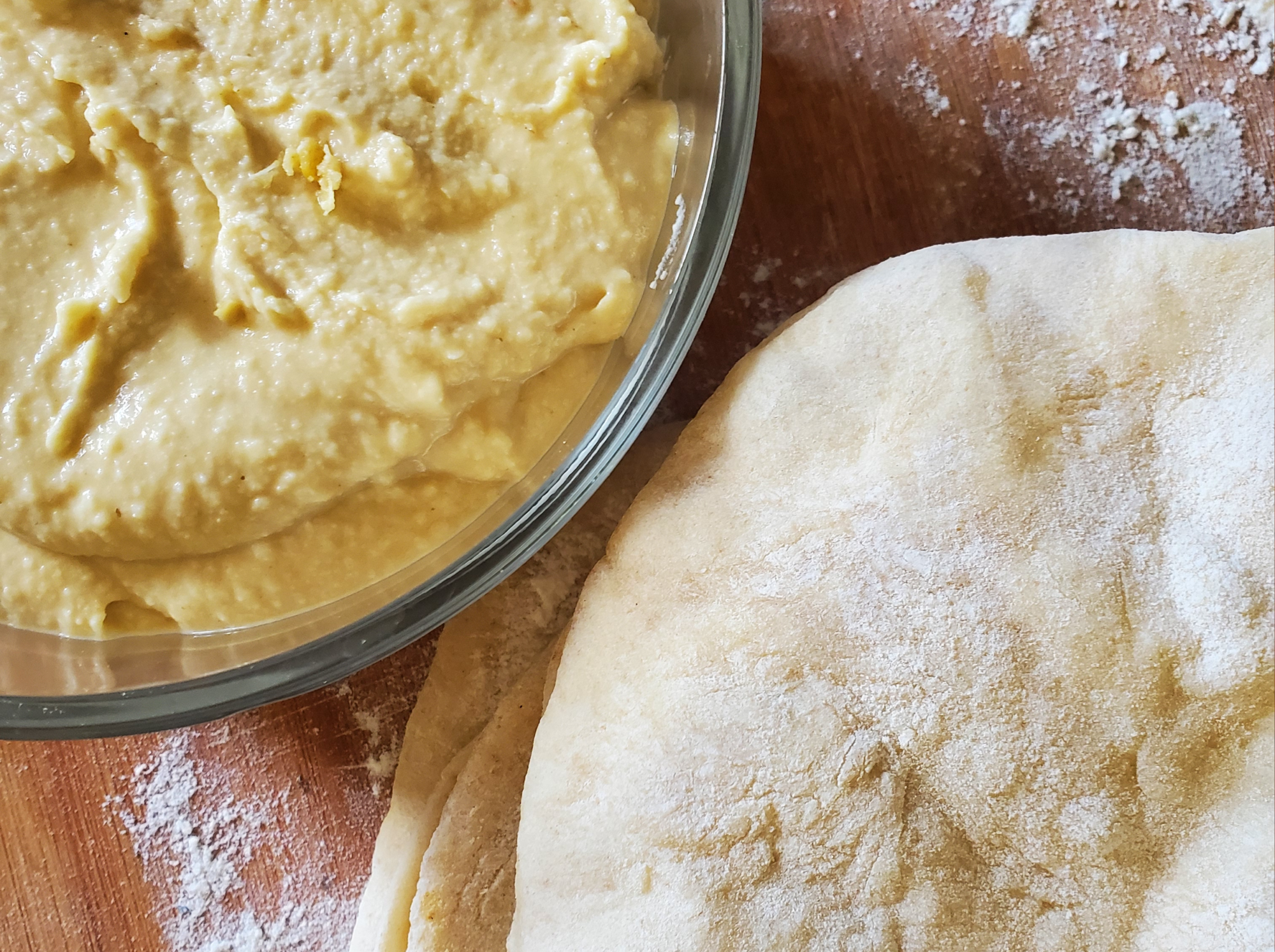
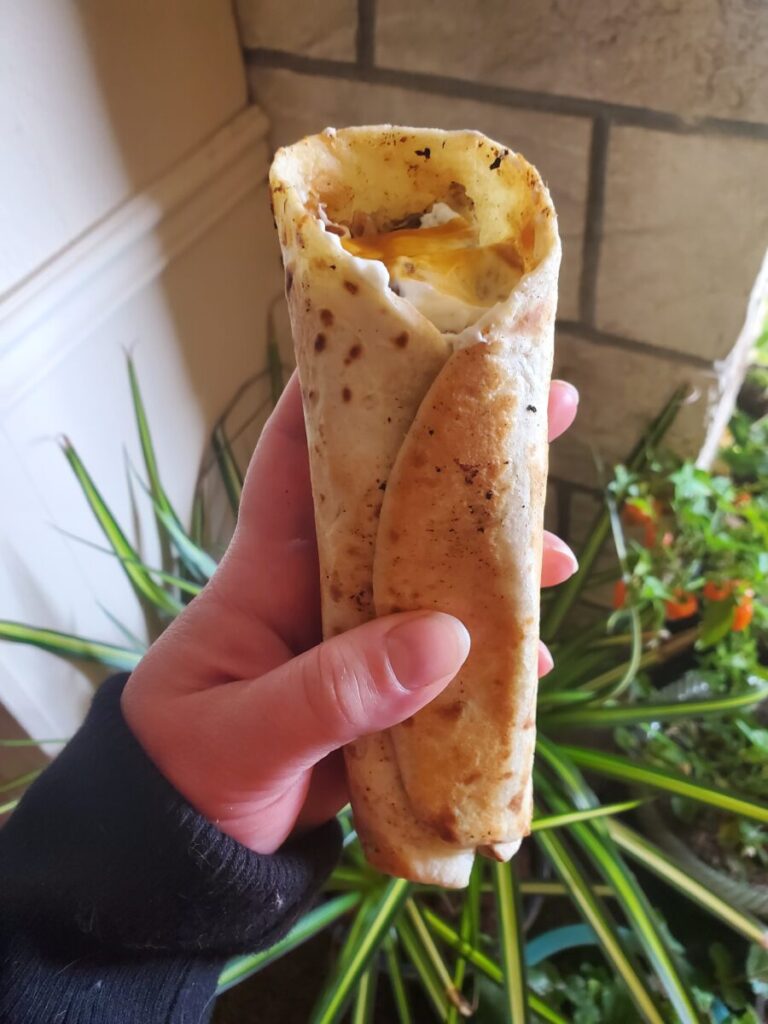
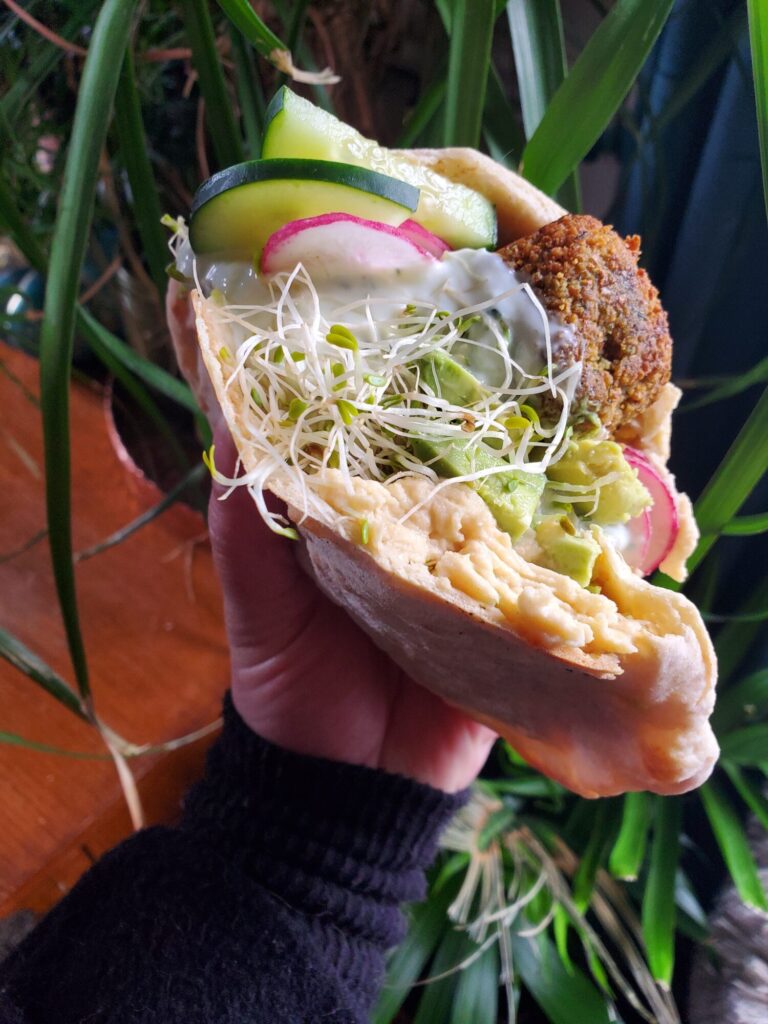
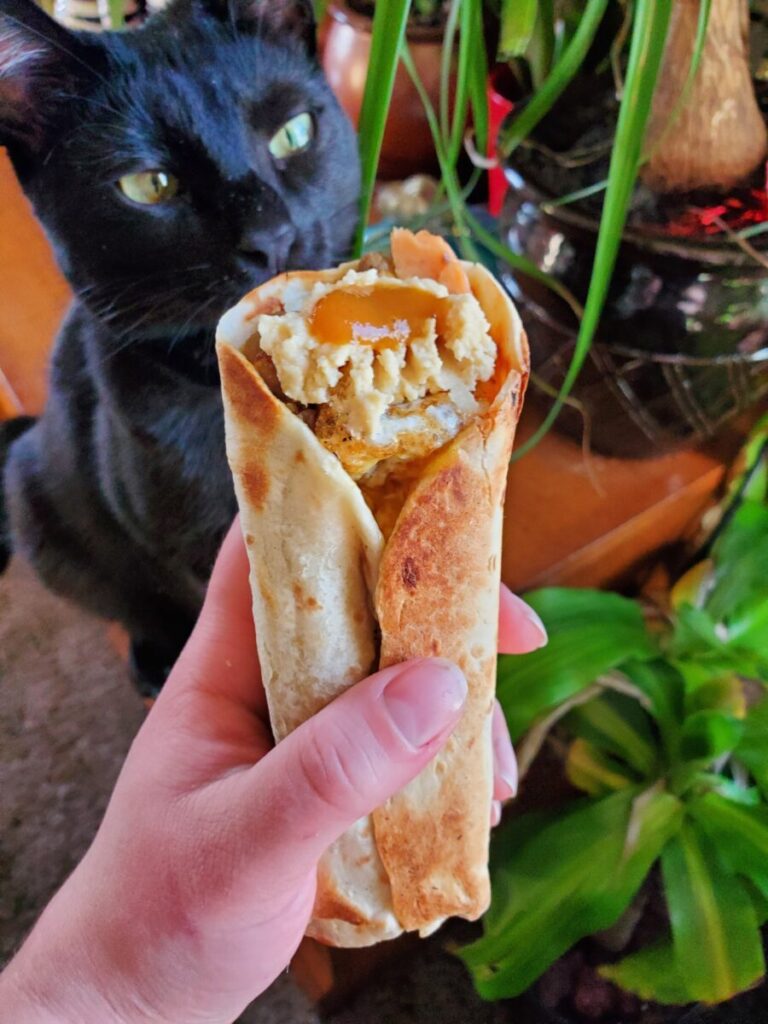
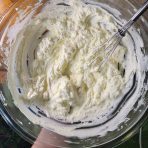
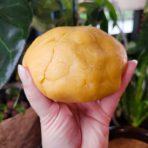
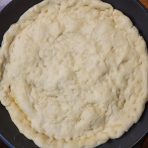
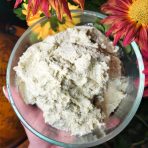
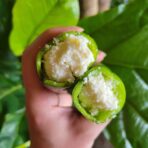
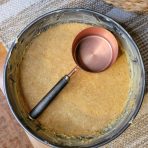
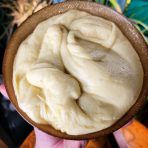

Leave a Reply